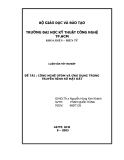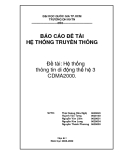
Hệ thống cellular
-
Có hai thế hệ trong các công nghệ di động được coi là tương tự. Các công nghệ này được gọi là 0G và 1G. 1G là công nghệ di động tổ ong (cellular) đầu tiên, còn 0G là công nghệ di động tiền tổ ong (pre – cellular).
 54p
54p  vinhxaban12
vinhxaban12
 17-12-2013
17-12-2013
 143
143
 15
15
 Download
Download
-
Tham khảo bài thuyết trình 'mạng thông tin di động số cellular', kỹ thuật - công nghệ, kĩ thuật viễn thông phục vụ nhu cầu học tập, nghiên cứu và làm việc hiệu quả
 56p
56p  ledanhgl
ledanhgl
 10-10-2010
10-10-2010
 335
335
 128
128
 Download
Download
-
HỆ THỐNG THÔNG TIN THẾ HỆ 3G CÁC TỪ VIẾT TẮT 3G Third Generation Cellular Hệ thống thông tin di động thế hệ thứ ba 3 GPP Third Generation Patnership Project Dự án hợp tác thế hệ 3 A AC AI AICH A-P ATM AS Admission Cotrol Acquistion Indicator Acquistion Indication Channel Access Preamble Asynchoronous Transfer Mode Access Slot Điều khiển cho phép Chỉ thị bắt Kênh chỉ thị bắt Tiền tố Kiểu truyền di bộ Khe truy nhập B BER BCH BMC Bit Error Rate Broadcast Channel Broadcast/Multicast Control Tỷ số bit lỗi Kênh quảng bá Điều khiển quảng bá / đa phương BS BSC...
 9p
9p  caott6
caott6
 22-05-2011
22-05-2011
 142
142
 28
28
 Download
Download
-
Các từ viết tắt ĐIỀU KHIỂN CÔNG SUẤT TRONG THẾ HỆ THÔNG TIN DI ĐỘNG 3UMTS CÁC TỪ VIẾT TẮT 3G Third Generation Cellular Hệ thống thông tin di động thế hệ thứ ba 3 GPP Third Generation Patnership Project Dự án hợp tác thế hệ 3 A AC AI AICH A-P ATM AS Admission Cotrol Acquistion Indicator Acquistion Indication Channel Access Preamble Asynchoronous Transfer Mode Access Slot Điều khiển cho phép Chỉ thị bắt Kênh chỉ thị bắt Tiền tố Kiểu truyền di bộ Khe truy nhập B BER BCH BMC Bit Error Rate Broadcast Channel Broadcast/Multicast Control Tỷ số bit lỗi Kênh quảng bá Điều...
 8p
8p  caott6
caott6
 22-05-2011
22-05-2011
 161
161
 39
39
 Download
Download
-
Kể từ khi được triển khai vào những năm đầu của thập niên 1980 cho đến nay.Thông tin vô tuyên di động đã và đang phát triễn với tốc độ hết sức nhanh chóng trên phạm vi toàn cầu .Kết quả thống kê cho thấy ở một số quốc gia ,số luợng thuê bao di động đã vượt hẳn số lượng thuê bao cố định.Trong tương lai .số luợng thuê bao di động và cố định sẽ tiếp tục tăng lên và song song với nó là sự gia tăng về nhu cầu của người sử dụng ....
 78p
78p  son2483
son2483
 23-01-2011
23-01-2011
 456
456
 217
217
 Download
Download
-
TOWARDS ‘ALL IP’ AND SOME CONCLUDING REMARKS This concluding chapter provides first an introduction to some of the planned release 5 enhancements to UMTS and the GPRS/EDGE RAN (GERAN). These can be seen as the first step towards ‘all IP’. The challenges when having to deliver real-time IP services over an air interface, in particular voice over IP services, are summarised and possible solutions to achieve spectrum efficiencies similar to those of optimised cellular voice services are outlined.
 18p
18p  huggoo
huggoo
 20-08-2010
20-08-2010
 95
95
 13
13
 Download
Download
-
Có hai thế hệ trong các công nghệ di động được coi là tương tự. Các công nghệ này được gọi là 0G và 1G. 1G là công nghệ di động tổ ong (cellular) đầu tiên, còn 0G là công nghệ di động tiền tổ ong (pre – cellular). Các thiết bị đầu cuối sử dụng trong 0G khó có thể gọi là thiết bị di động. Các mẫu mã đầu tiên rất lớn và thường được gắn vào xe ô tô. Sau đó, các thiết bị cầm tay ra đời, nhưng 0G bị thay thế bởi thế hệ kế...
 82p
82p  btnhat
btnhat
 28-03-2010
28-03-2010
 443
443
 162
162
 Download
Download
-
Introduction to the Oracle Server Technologies avoids these issues by formatting a report’s output as XML tags. Any client can request an XML Publisher report and (provided it has an XML parser) display the results. This is the key to distributing reports over wireless protocols to any device, such as a cellular telephone. Oracle Discoverer is an end-user tool for report generation. Oracle Reports and XML Publisher need a programmer to design the report.
 10p
10p  vongsuiphat
vongsuiphat
 04-01-2010
04-01-2010
 169
169
 27
27
 Download
Download


















